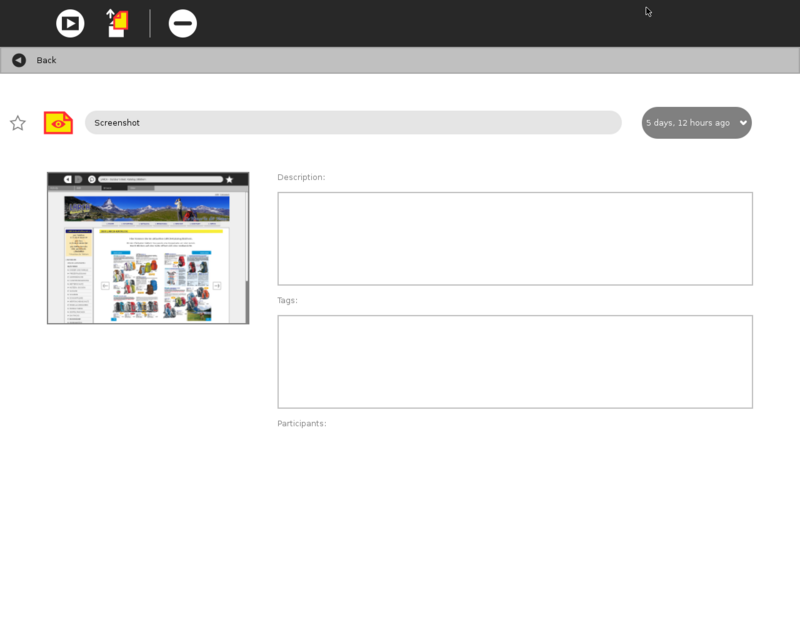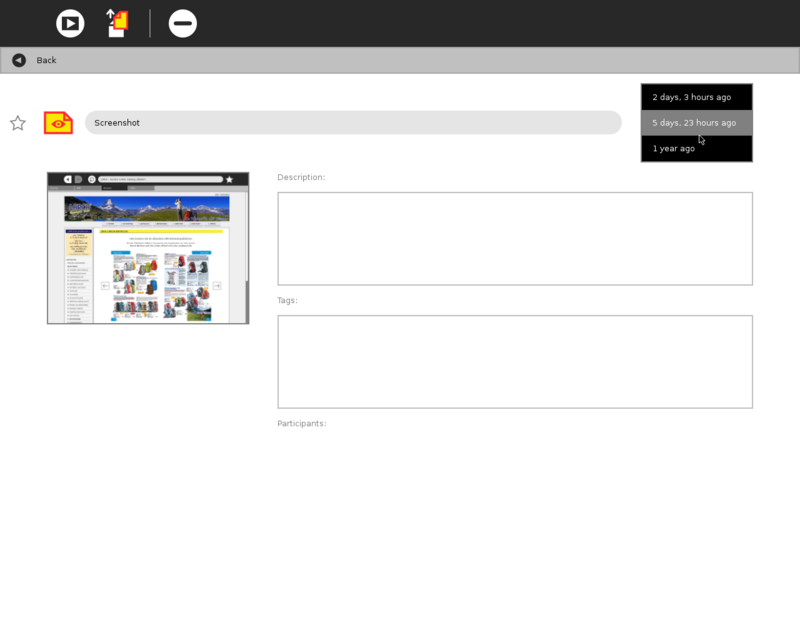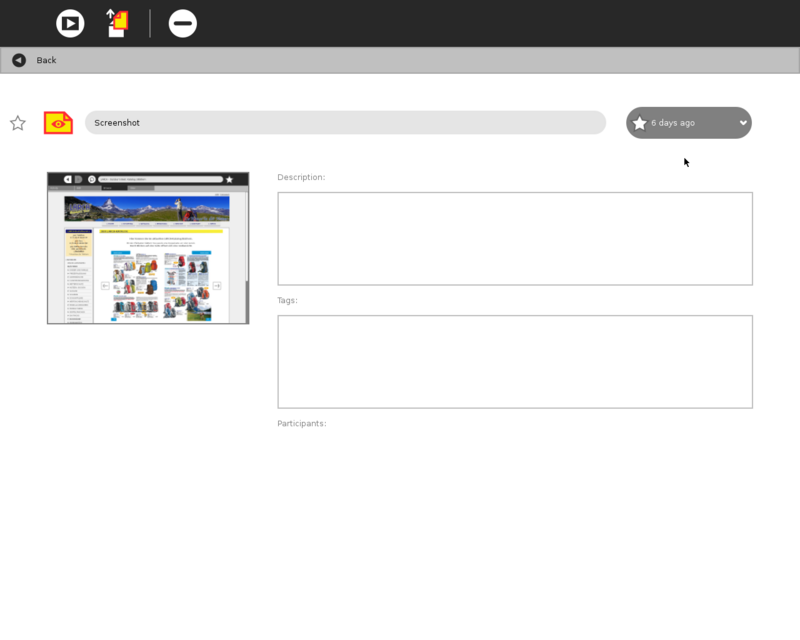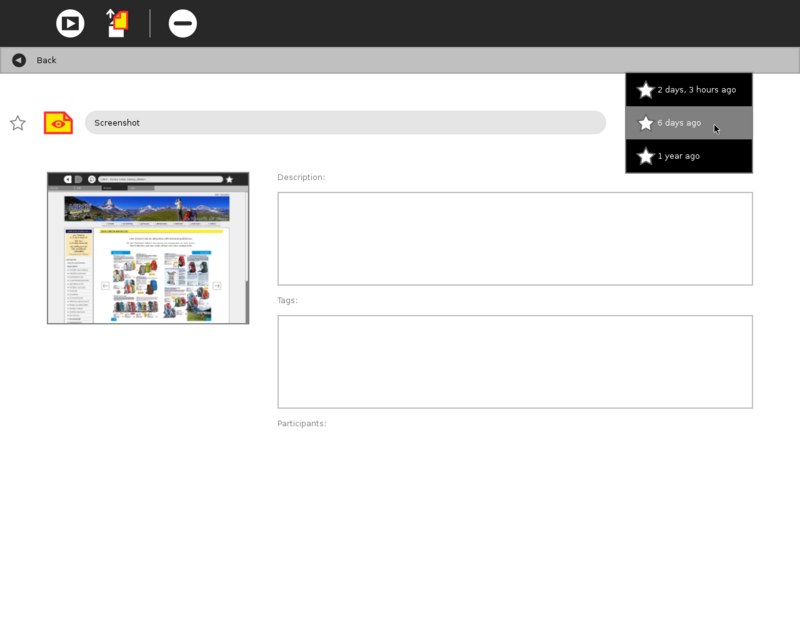Difference between revisions of "Talk:Version support for datastore/Proposal"
Jump to navigation
Jump to search
(update link for Google Doc) |
|||
| (4 intermediate revisions by 2 users not shown) | |||
| Line 7: | Line 7: | ||
[[Image:journal-version-mockup-4.png|800px|thumb|left|Third mockup: combo box with Favourite stars (closed)]] | [[Image:journal-version-mockup-4.png|800px|thumb|left|Third mockup: combo box with Favourite stars (closed)]] | ||
[[Image:journal-version-mockup-5.png|800px|thumb|left|Third mockup: combo box with Favourite stars (open)]] | [[Image:journal-version-mockup-5.png|800px|thumb|left|Third mockup: combo box with Favourite stars (open)]] | ||
| − | + | <br clear> | |
== Scratch area == | == Scratch area == | ||
| Line 24: | Line 24: | ||
:Basically, all versions of a document would appear within the list view timeline. Their order within the list would be determined by their timestamp. If I work on 3 iterative versions of a document, then go back to the second version and make changes, I get a new 4th version which appears as the most recent item in the Journal. It doesn't matter (at least here) that I technically have a branch at version 2, which has children 3 and 4. What matters in the Journal perspective is that I worked on version 4 most recently. The tree is flattened into a list in the time dimension. | :Basically, all versions of a document would appear within the list view timeline. Their order within the list would be determined by their timestamp. If I work on 3 iterative versions of a document, then go back to the second version and make changes, I get a new 4th version which appears as the most recent item in the Journal. It doesn't matter (at least here) that I technically have a branch at version 2, which has children 3 and 4. What matters in the Journal perspective is that I worked on version 4 most recently. The tree is flattened into a list in the time dimension. | ||
:This is also the reason that the latest Journal designs split the UI into "action" and "object" views. The action view would be a temporal history of everything you've done (with each version through time). The object view would represent each object only once, by it's most recent version, thus providing a much shorter list. | :This is also the reason that the latest Journal designs split the UI into "action" and "object" views. The action view would be a temporal history of everything you've done (with each version through time). The object view would represent each object only once, by it's most recent version, thus providing a much shorter list. | ||
| + | |||
| + | ;Eben & Tomeu: | ||
| + | This thread, http://www.mail-archive.com/sugar-devel@lists.sugarlabs.org/msg06008.html, consolidated in context, | ||
| + | |||
| + | https://docs.google.com/Doc?docid=0AbFyRSVE0dmOZGQ5emZjOTZfMzBoeG1qMjhqbg&hl=en | ||
| + | |||
| + | sugarlabs.org Google Docs original: | ||
| + | |||
| + | https://docs.google.com/Doc?docid=0AUl2E5uTm959ZGd3N3FucXdfMWhzbjVjeGht&hl=en | ||
=== IRC notes === | === IRC notes === | ||
| Line 73: | Line 82: | ||
= Datastore feature requests = | = Datastore feature requests = | ||
| − | + | * [[Development_Team/Release/Roadmap/0.86#Datastore_features_that_could_benefit_Library]] | |
| − | |||
| − | |||
| − | |||
| − | |||
| − | |||
| − | |||
| − | |||
| − | |||
| − | |||
| − | |||
| − | |||
| − | |||
| − | |||
| − | |||
| − | |||
| − | |||
| − | |||
| − | |||
| − | |||
| − | |||
| − | |||
Latest revision as of 01:22, 6 December 2010
UI mockups
Scratch area
Everything below isn't meant for public consumption, but just a reminder / place of reflection for me.
ML notes
- mtd
-
- it has to be simple and natural to prune old versions and documents
- ... and to display the disk usage of docs and their versions!
- it has to interop well with the FS underneath
- it has to interop with the XS-based backups...
- [storage/processing efficiency important]
- Eben
- Basically, all versions of a document would appear within the list view timeline. Their order within the list would be determined by their timestamp. If I work on 3 iterative versions of a document, then go back to the second version and make changes, I get a new 4th version which appears as the most recent item in the Journal. It doesn't matter (at least here) that I technically have a branch at version 2, which has children 3 and 4. What matters in the Journal perspective is that I worked on version 4 most recently. The tree is flattened into a list in the time dimension.
- This is also the reason that the latest Journal designs split the UI into "action" and "object" views. The action view would be a temporal history of everything you've done (with each version through time). The object view would represent each object only once, by it's most recent version, thus providing a much shorter list.
- Eben & Tomeu
This thread, http://www.mail-archive.com/sugar-devel@lists.sugarlabs.org/msg06008.html, consolidated in context,
https://docs.google.com/Doc?docid=0AbFyRSVE0dmOZGQ5emZjOTZfMzBoeG1qMjhqbg&hl=en
sugarlabs.org Google Docs original:
https://docs.google.com/Doc?docid=0AUl2E5uTm959ZGd3N3FucXdfMWhzbjVjeGht&hl=en
IRC notes
- bemasc
- Activities are stateless functions. That is, an Activity has no intrinsic state; if you start it blank, it's the same every time.
- All state lives in the Datastore. When you launch an Activity with a Journal entry as input, it produces output that goes back in the Journal.
- Consider what happens when a user "resumes" an entry twice, maybe even with two different activities. What should happen?
- It seems pretty clear to me that the result should be two entries, representing the output of each of these activities. [new branch, with same or different name]
- [example for whole-tree activity state: wine activity]
- [xdelta for binary diffs]
- [in-place execution of activities from datastore]
- "Running an activity" is a special system-level action available on objects of type "Activity". It specifically means "Executing the code in activity object X with a null input". The other action is "Open with {some activity}".
- another possibility is to ignore branches, and have each leaf ("head") simply show all of its ancestors as a list.
- The Actions view shows "a temporal view of what I did", and the Objects view shows "what I have".
- tomeu
- [opportunistic hardlinking using mtime+checksum]
- all activities should be able to read all journal instances written by past versions, but we cannot expect it will be that way
- silbe
- [filenames are just metadata]
- what about resuming old entries then? does it "run" the activity version it was created in?
- we could filter "temporally near" versions in the default view.
- instead of / in addition to the version tree view, we could have a filter that shows only the "related" (i.e. member of same version tree) documents in the regular Journal view
- [actions view out of scope]
- [multiversion XIP support similar to tla: hardlinked/sparse revision library + working copy hardlinking from revision library]
- homunq
- [evaluate bazaar etc. as backend] -- SS: potential conflict with XIP - though git might be fine
- [run activities directly from zip file]
- In the main journal list, you can have old versions in the palette, much like the new resume-by-default behaviour in current home view. In journal details, I guess you could have "previous" and "next" buttons as the simple first pass, I'd like a list of versions even better.
- I'd argue that showing separate versions separately in journal list will never be the right thing. I'd rather have ALL old versions totally invisible in journal list (only accessible through "prev/next version" buttons in detail view) than have anything.
- [in response to current Journal being temporal view, so intermediate versions should be there] OK, but they should be grouped, and collapsed by default, to show just head
- I think the simplest, usable prototype would be what I said: just head in list, prev/next buttons in details.
- for now, I'd accept tags as either by-version or global, but mutable and not versioned themselves
- it's really a question of UIs and workflows, and having the prototype will help us actually test some workflows and get a more-informed conversation
Gnome work
- first part and
- second part of Roadmap mail.
- GNOME Zeitgeist




